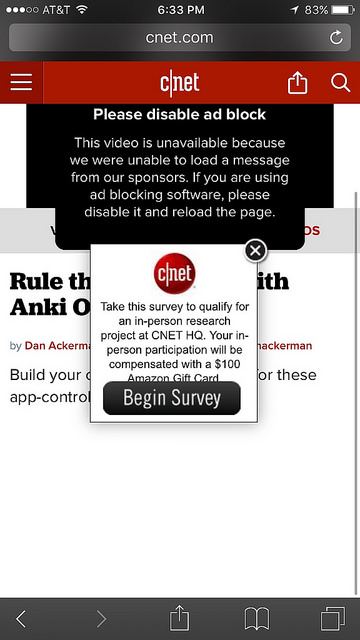
Image source: Scott Shiller via Flickr
Ad blockers continue to spread robustly, threatening brands’ digital advertising and the revenue model of online publishers. Earned media and native advertising – with the help of public relations expertise – could help solve the problem.
The number of desktop and mobile devices with ad blockers grew by 142 million worldwide to reach 615 million devices last year, a 30% increase, reveals the 2017 Global Adblock Report from PageFair.
Ad blockers have room to grow. Although mobile ad block usage surged in Asia-Pacific by 40% in 2016, just 11% of the global internet population blocks ads. Ad block penetration in the U.S. and U.K. is only 1%.
“Mobile ad block usage is growing explosively in Asia and is set to spread to North America and Europe as well,” the PageFair report states. “No obstacles exist to prevent an equally rapid expansion of similar forms of mobile ad blocking on mobile devices in North America and Europe.”
Workable Solutions are Difficult to Implement
Websites have tried technologies that re-insert ads and asking viewers to pay for content. “Regardless of the options websites choose, the onus is on them to figure out a way to monetize their content. And it’s been clear: Finding a workable solution around ad blocking has proven to be tough,” concludes Mimi An, market research analyst at HubSpot.
Some experts argue that native advertising is an effective response to ad blockers. As a relatively new form of paid media, native ads mimic the style, appearance of the website’s editorial content. It’s paid advertising that looks like editorial content.
“It’s a win-win-win scenario: Viewers get an enhanced user experience; the brand gains the publicity it seeks; and the publisher retains its ad revenue and traffic,” writes Bill Simmons, CTO & Co-founder of DataXu, in a post for ExchangeWire.
Native ads keep up with current digital behaviors. Consumers now spend more time skimming their social feeds on Facebook, Twitter and other platforms than surfing the wider web where banner ads predominate.
Native ads are also effective. According to ShareThrough and IPG, 25% more consumers look at native ads than banners, and 52% more consumers look at native ads than display ads, Simmons says.
New Guidelines to Boost Native Advertising
New standards for the real-time trading of native ads, the IAB’s OpenRTB Native1.1guidelines, will further boost the marketing strategy, Simmons contends. “Native ads traded programmatically can be targeted with precision,” he states. “With help from first- or third-party data, marketers can use native to make sure their ads are placed in front of a highly specific subset of consumers.”
With the exchange, native ads will be highly adaptable to the user experience. They will be more scalable. Copy and creative will be easily plugged into campaigns, since the exchange automatically selects the image and text for appropriate ad campaigns.
An Opportunity for PR
Public relations has an opportunity to benefit from growth in native advertising. PR storytelling skills are well suited to creating compelling native ad content.
A survey of PR agencies in the UK indicated that nine out of 10 see native advertising as an opportunity. Three-fourths of agencies believe they are the best choice to create and distribute native advertising content for brands. The survey commissioned by native advertising platform Adyoulike contacted senior directors and heads of digital at 76 top PR agencies in the UK.
“Public relations professionals are well trained to carefully examine all factors that impact reputation development including advertising,” states Janet Robinson, former CEO of The New York Times Company, for the Center on Reputation. “In short, they are essential contributors to this special and sometimes misunderstood marketing effort.”
“The creation of quality native advertising is an important first step in the process but monitoring the impact, the reaction, the social buzz and the effectiveness of this form of advertising is also vital,” Robinson adds.
Native Ad Drawbacks – Earned Media Advantages
However, native ads are expensive. They also face the risk of being overly self-promotional. Consumers quickly become disillusioned if they feel the content is selling something and become less inclined to view other sponsored content from the brand or articles on the website.
Earned media, PR in other words, is impervious to ad blocking and has greater credibility than advertising. With creative development of earned media placements, both traditional and social media can be very effective in communicating brand messages normally delivered through advertising.
Bottom Line: Earned media and native advertising may be effective antidotes to ad blockers, which continue to spread rapidly and place digital publishing revenue models at risk. By creating ads that match a website’s editorial content in form and function or by creating actual editorial content that’s really interesting, brands can gain consumers’ attention. Smart brands will turn to their PR departments or agencies, who have the skills to create compelling content and monitor the effectiveness of the ads.
William J. Comcowich founded and served as CEO of CyberAlert LLC, the predecessor of Glean.info. He is currently serving as Interim CEO and member of the Board of Directors. Glean.info provides customized media monitoring, media measurement and analytics solutions across all types of traditional and social media.




